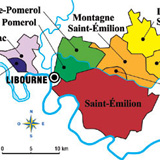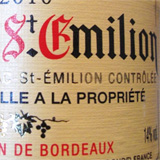Saint Emilion AOC vineyards are located 35km near Bordeaux on the 'right bank' of the Dordogne River - where Saint-Emilion is registered as a world heritage site by UNESCO. Saint-Emilion's fame is due to its unique situation and soil to be found in the area.
For several historical reasons before the French revolution in 1789, St-Emilion's was divided into thousands of plots. The current average size of the properties of Saint-Emilion doesn't exceed 7 ha, which is small when compared to the Medoc wine estates being approx five times the size. Fortunately this historical inheritance turned out to be an advantage when vines were planted around the small town of St-Emilion because of the astonishing diversity of the local soils. St-Emilion is covered with a thick molasse layer of calcareous, sandstones, shales and conglomerates of shallow marine deposits. Saint Emilion is assigned to five main areas based on the type of soil: Cote Sud, or South - Graves de Figeac - the West coast - the North coast and the plateau of St-Martin. With the exception of the gravelly soil of the Graves de Figeac on which the Cabernet Franc and Cabernet Sauvignon varietals are particularly well adapted, St-Emilion is the home of Merlot, which makes up a dominant portion of the red wine blends.
Since 1955, there has been a classification of Saint-Emilion wine, and is updated every 10 years or so (last in 2006), and consists of the following levels: Premier grand cru classe A, Premier grand cru classe B, and Grand cru classe. As of the new classification in 2012, there are currently four estates at the highest level: Chateau Angelus, Chateau Ausone, Chateau Cheval Blanc and Chateau Pavie.
St-Emilion's Merlot dominated wines are often less austere than their cousins of the Medoc region. They Saint-Emilion wines are fully rich, velvety, fruity, elegant and powerful. After 10-15 years of ageing, the wines of Saint-Emilion tend to gain complexity from their initial aromas by integrating rich leather, earthy and spicy flavours.










